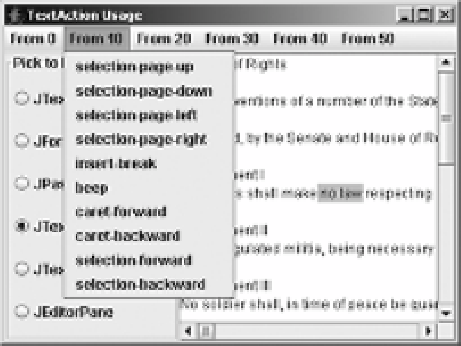Java Reference
In-Depth Information
Figure 16-2 shows some of the available operations for a
JTextArea
. When you select the
different menu options, the
JTextComponent
is appropriately affected.
Figure 16-2.
TextAction list usage demonstration
This technique is useful because it shows that you can readily discover the supported
operations of a text component and provide access to that behavior without knowing precisely
what the actual behavior is. This is just one demonstration of the many ways you can use
TextAction
objects.
Finding Actions
Although listing and using
Action
objects related to a text component is a fairly malleable
process, unless you know what you're looking for, it isn't very useful. Thankfully, the
DefaultEditorKit
has 46 class constants that match many of the shared 46 (out of 53)
Action
objects of all the text components. The class constants' names more or less reflect their function-
ality. The
JTextField
adds an additional constant for the
Action
shared with
JFormattedTextField
and
JPasswordField
. Unfortunately, the names associated with the extra actions available to
the
JTextPane
aren't class constants of any text component and are just used internally within
the
StyledEditorKit
, where you will find the additional
Action
implementations defined.
■
Note
One additional
Action
exists primarily for debugging purposes. Its
Action
name is
dump-model
,
and it lacks a class constant to go with it. When initiated, the method literally dumps out the
Document
model
Element
structure for the text component.
Table 16-1 lists the 47 constants available to help you locate the predefined
Action
you're
seeking.



